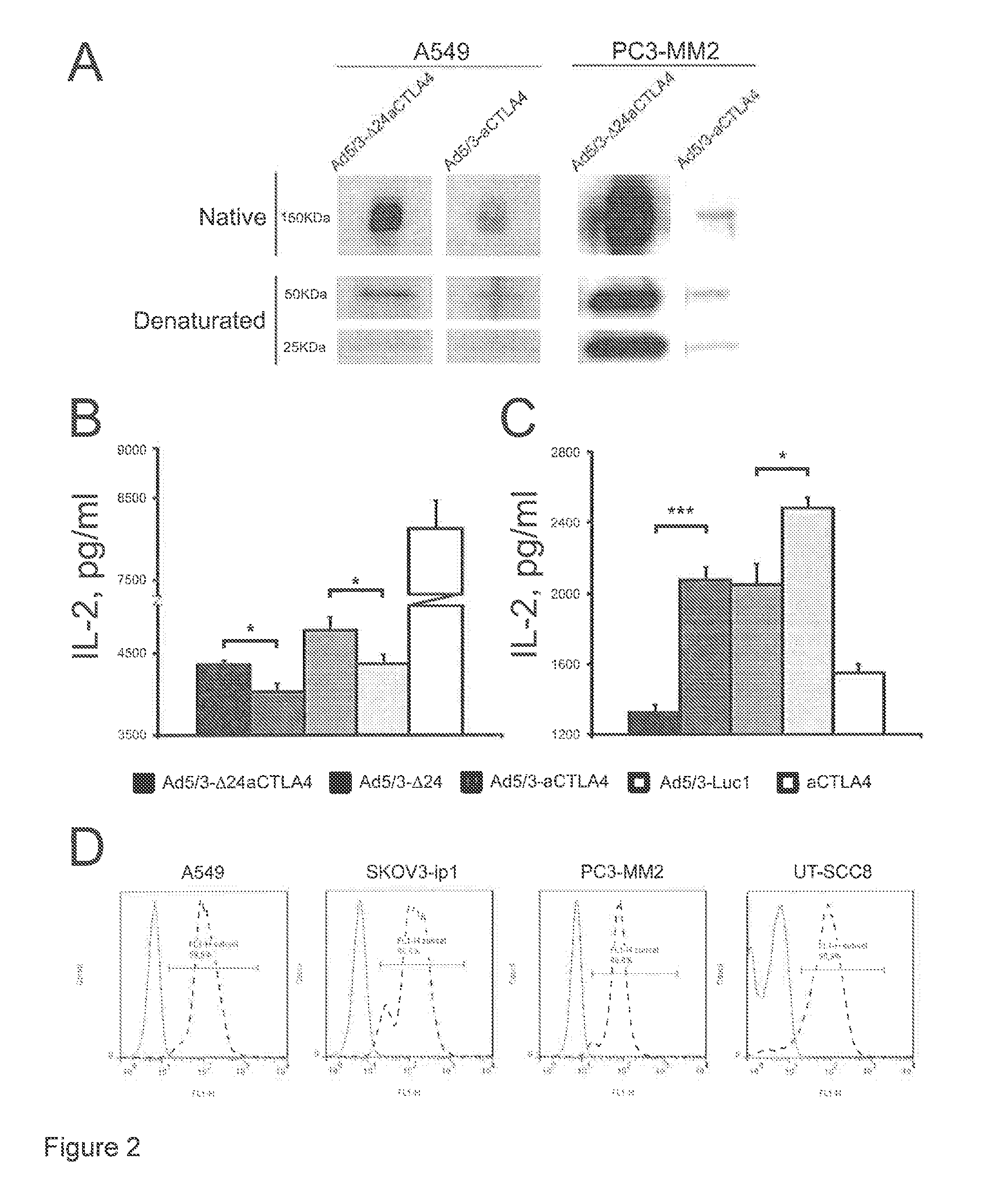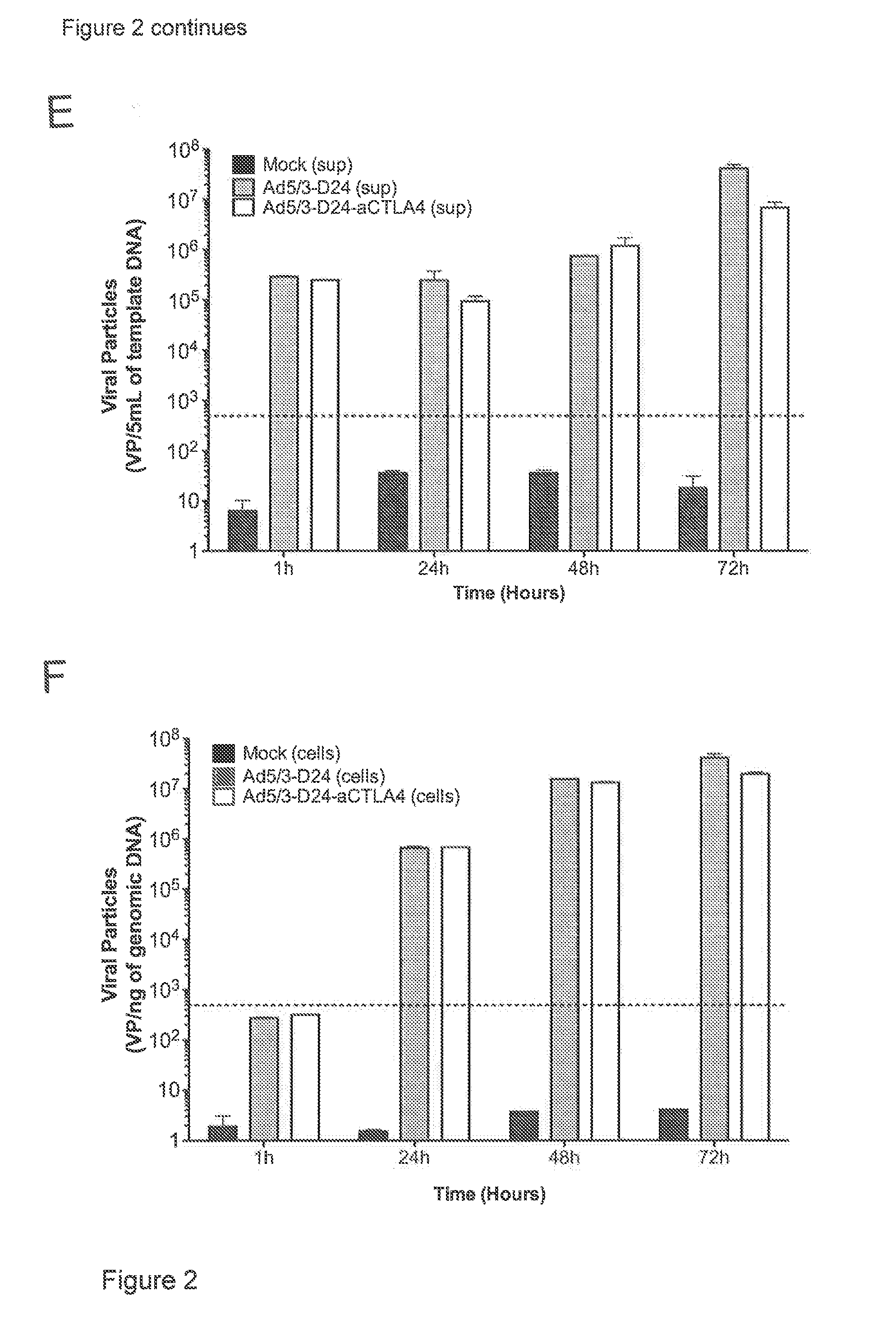Oncolytic adenoviral vectors coding for monoclonal Anti-ctla-4 antibodies
a technology of adenovirus and monoclonal antibodies, applied in the field of life sciences and medicine, can solve the problems of inability to cure cancer, low expression, limited antitumor efficacy, etc., and achieve the effect of increasing the capacity high e2f levels, and increasing the ability of adenovirus to stimulate tlr9
- Summary
- Abstract
- Description
- Claims
- Application Information
AI Technical Summary
Benefits of technology
Problems solved by technology
Method used
Image
Examples
example 1
Construction of Adenoviruses
[0149]Chimeric adenoviruses bearing the cDNA sequence coding for an IgG2 type anti-CTLA4 mAb were generated (FIG. 1). The coding sequence of anti-CTLA4 mAb was introduced into the 6.7K / gp19K deletion of adenoviral E3A to create replication competent adenoviruses Ad5 / 3-Δ24aCTLA4 (SEQ ID. NO:1), Ad5 / 3-hTERT-Δ24aCTLA4 (SEQ ID. NO:2), Ad5 / 3-hTERT-Δ24aCTLA4-CpG (SEQ ID. NO:3), Ad5 / 3-E2F-Δ24aCTLA4 (SEQ ID. NO:4), and Ad5 / 3-E2F-Δ24aCTLA4-CpG (SEQ ID. NO:5) or into the deleted E1 driven by CMV promoter to create replication deficient adenovirus Ad5 / 3-aCTLA4 (SEQ ID. NO:6).
[0150]The oncolytic adenoviruses were generated and amplified using standard adenovirus preparation techniques (Kanerva A, et al., Mol Ther 2002; 5:695-704; Bauerschmitz G J, et al., Mol Ther 2006; 14:164-74; Kanerva A and Hemminki A., Int J Cancer 2004; 110:475-80; Volk A L, et al., Cancer Biol Ther 2003; 2:511-5). Briefly, either an E1 or E3 shuttle vector with the transgene and other moieties...
example 2
Expression and Functionality of the Constructed Adenoviruses In Vitro
[0155]Western blot analysis was used to confirm that the constructed adenoviruses express anti-CTLA4 mAb. A549 or PC3-MM2 tumor cells were infected with the constructed Ad5 / 3-Δ24aCTLA4 or Ad5 / 3-aCTLA4 at 10 Virus Particles (VP) per cell. After 48 h, the supernatants of virus infected cells were filtrated with 0.02 μm filters (Anotop, Whatman, England), 15 μL were run on a 7.5% SDS-polyacrylamide gel electrophoresis (PAGE) gel under reducing or native conditions and transferred onto a nitrocellulose membrane. The membrane was incubated with goat anti-human IgG (heavy and light chains) (AbD serotec, MorphoSys, Germany), washed and incubated with a secondary antibody coupled to horseradish peroxidase (Dako, Denmark). Signal detection was done by enhanced chemiluminescence (GE Healthcare, Amersham, UK).
[0156]In Western blot, Ad5 / 3-Δ24aCTLA4 and Ad5 / 3-aCTLA4 expressed the expected approximately 150 kDa anti-CTLA4 mAb in...
example 3
CTLA-4 Expression of Tumor Cell Lines and Low-Passage Tumor Explants
[0163]Since it has been reported that almost 90% of the tumor cell lines express CTLA-4 and that anti-CTLA-4 mAb might have direct anti-tumor activity (13), it was investigated whether that was true also in the tumor cell lines including the HNSCC low-passage tumor explants used.
[0164]Indirect immunofluorescence was performed in low passage tumor cell culture UT-SCC8 or in tumor cell lines A549, SKOV3-ip1 and PC3-MM2 for analyzing the surface CTLA-4. Briefly, the cell pellet was incubated for 30 min at 4° C. with mouse anti-human CTLA-4 mAb (BD Pharmingen™, Europe) as primary antibody followed by incubation for a further 30 min at 4° C. with an Alexa Fluor® 488 donkey anti-mouse IgG (Invitrogen) as secondary antibody. The fluorescence intensity was measured on a LSR flow cytometer (BD Pharmingen™, Europe). At least 40 000 cells / sample were counted. A Clontech Discovery Labware immunocytometry systems (BD Pharmingen™...
PUM
| Property | Measurement | Unit |
|---|---|---|
| Ratio | aaaaa | aaaaa |
| Immunogenicity | aaaaa | aaaaa |
Abstract
Description
Claims
Application Information
 Login to View More
Login to View More - R&D
- Intellectual Property
- Life Sciences
- Materials
- Tech Scout
- Unparalleled Data Quality
- Higher Quality Content
- 60% Fewer Hallucinations
Browse by: Latest US Patents, China's latest patents, Technical Efficacy Thesaurus, Application Domain, Technology Topic, Popular Technical Reports.
© 2025 PatSnap. All rights reserved.Legal|Privacy policy|Modern Slavery Act Transparency Statement|Sitemap|About US| Contact US: help@patsnap.com



